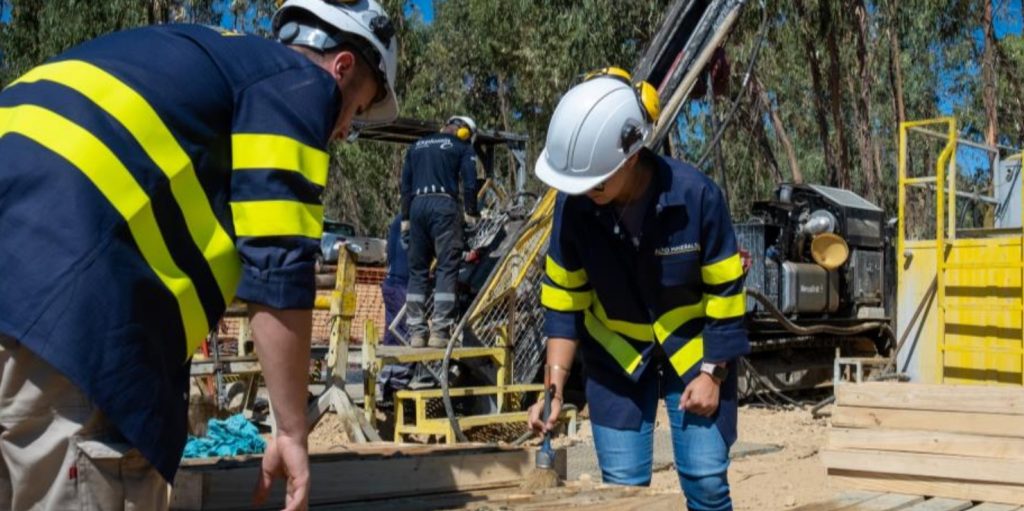Denarius Metals drills 10.96% CuEq over 10.25 metres at Lomero, Spain

Denarius Metals Corp. [DSLV-TSXV; DNRSF-OTCQX] has received the final assays for 42 drill holes, mainly infill holes, totalling approximately 13,225 metres from the phase 2 surface validation and infill drilling program on its polymetallic Lomero project in southern Spain.
To date, Denarius Metals has completed approximately 41,850 metres of drilling in 128 drill holes, including twinning of historical drill holes. The infill phase, totalling 23,920 metres and representing 57% of the total drilling program, is now complete. A final 4,000 metres validation drilling campaign, designed to finish verifying the high-grade underground drill holes drilled in the 1980s by Indumetal/Billiton, is in progress. The full drilling results will be incorporated into the geological model and will be integrated in the mineral resource estimate (MRE) update to be completed in conjunction with a preliminary economic assessment (PEA) in the second half of 2023.
Key takeaways from the exploration work carried out at the Lomero project to date include: Phase 2 validation and infill drill holes completed on the central part of the deposit have mostly intersected significant copper mineralization in massive sulphides, showing better grades than the Cu (copper) average grade of the current MRE, ranging from 0.6% up to 1.86% over intervals up to 15.7 metres thick.
Phase 2 infill drill holes completed on the eastern part of the deposit have intersected significant zinc and lead mineralization, showing much better grades than the Zn (zinc) and Pb (lead) average grades of the current MRE, ranging for Zn from 1.08% up to 11.01% over intervals up to 6.65 metres thick, and for Pb from 1.55% to 5.05% over intervals up to 6.65 metres thick. Infill drilling has also, confirmed high zinc and gold grades over widths that widen to depth at the westernmost end of the permit. Zinc and lead mineralization is hosted primarily in the massive sulphide domain and, to a lesser extent, in the semi-massive sulphide domain.
Validation by directional drilling of the underground drilling program completed in the 1980s by Indumetal/Billiton in short, less than 60 metres, horizontal holes from underground stations was successful in returning exceptional high grades from the polymetallic mineralization hosted in the lower part of the historical mine, with drill hole LPDV002 intersecting 10.25 metres grading 0.27% copper, 4.79% lead, 9.82% zinc, 161 g/t Ag (silver) and 6.82 g/t Au (gold).
A PEA-level metallurgical testwork program commenced in April, 2023, at Grinding Solution U.K.’s facilities. The testwork will be completed using two separate composites, one semi-massive sulphide and one massive sulphide, with samples collected from drill cores produced during the company’s phase 1 and phase 2 drill campaigns.
Serafino Iacono, Executive Chairman and CEO of Denarius Metals, commented, “We are encouraged by the Phase 2 drill assays validating the lateral and horizontal continuity of the massive sulphide and semi-massive sulphide mineralized lenses and confirming the presence of higher-grade mineralized zones within the broader resource envelope. In addition, the initial drill assays from the validation drilling program in process are very promising and could potentially increase the grades in the current geological model. For the balance of 2023, activities at the Lomero Project will be focused on completion of the PEA, additional engineering studies to support the future development of the project and execution of the planned greenfield exploration program. The greenfield exploration program comprises 6,000 metres of drilling aimed at increasing the tonnage of the MRE update based on Phase 1 and Phase 2 drilling, targeting the Las Merinas and Alianza areas located along two main shear zones discovered in 2022 by field mapping, located to the south and to the north of the shear zone that hosts the Lomero-Poyatos deposit and both of which are E-W trending.”
The Phase 2 surface validation and infill drilling program commenced in October 2022 and was completed in February 2023.
Key Highlights: Validation and infill drill holes completed on the central part of the deposit mostly showed cupriferous mineralization with maximum intersection grades of 1.86% Cu, 21 g/t Ag and 2.85 g/t Au over 6.70 metres (LM22091), 1.23% Cu, 7 g/t Ag and 1.67 g/t Au over 15.70 metres, including 1.65 metre at 1.86% Cu, 15 g/t Ag and 0.61 g/t Au (LM22085), and 1.43% Cu, 16 g/t Ag and 1.34 g/t Au over 6.30 metres (LM22084).
Infill drill holes completed on the eastern part of the deposit mostly showed significant zinc and lead mineralization with maximum intersection grades of 6.12% Pb, 11.01% Zn, 95 g/t Ag and 4.01 g/t Au over 2.50 metres (LM22110), 3.43% Pb, 7.54% Zn, 88 g/t Ag and 5.30 g/t Au over 2.30 metres (LM22113), and 3.68% Pb, 3.56% Zn, 127 g/t Ag and 5.62 g/t Au over 1.70 metres (LM22116).
Drill hole LM23103 confirms high zinc and gold grades at depth at the westernmost end of the permit, returning 0.32% Cu, 0.95% Pb, 2.04% Zn, 37 g/t Ag and 3.79 g/t Au over 6.65 metres, including 2.15 metres at 0.40% Cu, 1.29% Pb, 2.66% Zn, 52 g/t Ag and 5.09 g/t Au, demonstrating that the deposit remains open to the west.
Validation by directional drilling of the underground drilling program completed in the 1980’s by Indumetal/Billiton using a series of short <60-metre horizontal holes from underground stations was successful in confirming the high-grade polymetallic mineralization present in the lower part of the historical mine, with drill hole LPDV002 intersecting 10.25 metres grading 0.27% Cu, 4.79% Pb, 9.82% Zn, 161 g/t Ag and 6.82 g/t Au.
Metallurgical test work is ongoing.
